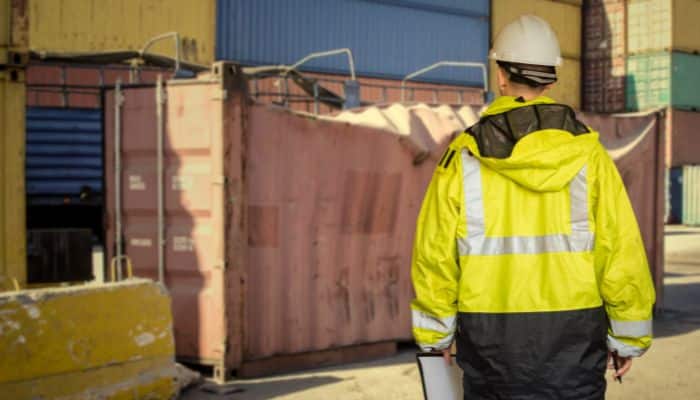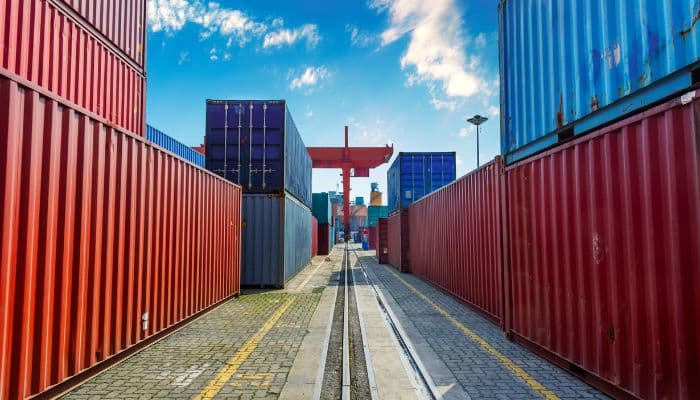Damaged Shipping Containers – Causes And Types
The modern-day shipping container is undoubtedly one of the most useful inventions of our time. From the days of hand-loading and unloading cargo boxes and items of different sizes and shapes, we have come a long way. From ordinary corrugated steel containers of the 1950s – 70s, today, we use containers made of high-quality Corten steel.
These heavy-duty containers are tough enough to withstand the knocks and bumps while being moved from one location to another by the different modes of transport – rail, truck, or ship. They can also withstand harsh weather conditions and are corrosion-resistant. They provide safety and security to the products within.

A well-maintained shipping container is watertight as well as airtight. These qualities make them ideal for transporting goods by sea, especially perishable goods.
But however tough they may be and as nature dictates, all elements are subject to ‘wear and tear and the efflux of time’.
Now, the question is, ‘Are such tough shipping containers prone to damage?’.
The simple answer is yes; shipping containers may get damaged when they are handled carelessly or due to natural disasters.
They may be damaged in the following situations:
- While in storage at the container yard
- During the handling and movement of the empty container
- While loading cargo at the shipper’s premises
- During the movement of the laden container by overland transport
- While sailing onboard a ship
- Unloading of the container at the port
- While unloading cargo at the consignee’s premises
- Returning the empty container
Causes of Container Damage
Careless Handling
A multimodal container is normally transported from one location to another by overland transport, such as rail or road, before it reaches the quayside for loading onboard a ship. In the process, it is lifted and moved several times, changing its position. Unless handled carefully, the container can get damaged easily.
Careless or inexperienced MHE operators can cause containers to hit against each other and result in extensive damage.
Heavy-duty cranes and forklifts have to be used carefully to avoid collisions with parked containers. Similarly, when containers, either laden or unladen, are not stacked properly, it can cause them to shift and collapse, causing damage to adjacent containers or property.

Lack of Training
Pallets have to be loaded correctly. Overloading of cargo or uneven weight distribution can cause it to topple over and, in turn, upset the container balance.
Loading and unloading staff have to ensure that pallets are stacked evenly and on a level surface. Overloading of cargo inside a container can cause the floorboard to sag and eventually crack.
Similarly, uneven weight distribution within a container can damage the container floor or cause it to topple from the trailer bed. In many cases, poor container yard conditions are also to blame for container damage.
Improper locking of the container to the trailer bed is a major cause of accidents while being transported over land. Besides ensuring that the container truck and trailer bed are in good condition, the driver of the truck has to ensure that the twist locks are engaged properly and the container secured. Reckless driving of container trucks can result in serious accidents.
During sailing, rough seas and harsh and inclement weather conditions may cause containers to break out of their lashings and get washed away into the sea. This may be the case, especially when a container is not secured properly onto the ship’s deck.
Some of them sink quickly to the ocean floor, while others may float for some time before sinking to the bottom. Containers that get knocked around on the deck or the ship’s hold can cause extensive damage to the ship as well as other containers on board, besides the goods inside getting damaged.
Dangerous Goods
Certain highly inflammable materials, like chemicals, can cause fire within the container while being transported if they are not packed properly following the manufacturer’s instructions.
Force Majeure
Natural disasters can cause damage and destruction to shipping containers or cargo. While most such disasters are completely unavoidable, steps can be put into place to minimise damages and loss.
In all cases, the cargo that a container carries must not deteriorate in quality and should reach its destination safely. A compromised cargo container can result in damage to the cargo within. Once damaged, certain types of goods may be dangerous for the port staff or other material handling equipment (MHE) to handle. It may result in grievous injuries or even fatalities.
Training and Best Practices
MHE operators, container truck drivers, and all those staff involved in the loading, unloading, and transportation of cargo have to be educated and trained properly on best practices to prevent accidents and damages.
Types of Container Damages
Container damages are generally classified as follows:
Damages to Container Door
The container door is made up of several parts, making it vulnerable to damage. Besides the Corten steel body of the door, it consists of the locks, the lock rods, hinges, and the rubber gasket. A shipping container with a door that does not close and seal properly is considered a damaged container. Also, an intact CSC plate issued by the relevant authorities, fixed on the container door, is mandatory for all international container cargo movements.
Dents
A dent is a local depression on the container wall that is normally caused by an impact.
Bulges
Bulges are normally smooth depressions that protrude outward or inward from the container wall.
Scratches
Scratches are caused by a sharp object, such as the forks of a heavy-duty forklift, when it hits and drags along the surface of the container without piercing it completely.
Fractures and Cracks
These are breaks on the container surface, normally in the form of a line, that may or may not have penetrated the steel wall of the container.
Tears
When the container wall is penetrated, and the two sides are pulled apart, we have a tear.
Holes
When a sharp object penetrates the container wall, it can cause a hole. Holes on a damaged shipping container can also be in the form of a perforation.
Dents, bulges, and scratches may or may not have damaged the goods that are stored in that particular area of the container.
Claiming Compensation for Damage
What are the steps to follow in case a shipping container is received in damaged condition?
The first step would be to take clear photographs of the damage, showing the container number and CSC plate. The next would be to inform the cargo carrier, your insurance company, and the shipper of the damage and the value of the damage if it can be worked out at that time.
The necessary shipping documents have to be provided to these parties to claim compensation. They are:
- Statement of claim showing details of the loss
- Bill of lading
- Proof of delivery of goods
- Insurance papers
- The invoice showing the quantity and value of goods
- Photographs of the damage
Following this, the insurance company will conduct a survey to ascertain the damage and its cause. Sometimes, the shipper, as well as the consignee’s insurance companies, will conduct a joint survey.
Once the surveyors agree on the cause and decide on who has to compensate and the amount to be paid to the consignee, the mode of disposing of the damaged goods is agreed upon and executed at an agreed date.
Certification of Shipping Containers
Who confirms the seaworthiness of a shipping container? Every country that is party to the CSC (Container Safety Convention 1972) has an Administration department that is in charge of issuing the CSC plates to seaworthy containers.
Upon request, certified third-party container inspectors will conduct a thorough inspection of a container to certify to the Administration of the respective country that the container is up to specifications and seaworthy. The Administration will then issue a CSC plate that is affixed to the container door.
Certified Third-party Container Inspectors
Such an inspection by certified third-party container inspectors covers the material of the container, the outside including the underside of the container, the doors, the inside, the ceiling, walls, and vents, if any. The exact dimensions of the container, as well as any repair work carried out on the container, are also taken into account during this inspection.
What Happens to Damaged Shipping Containers?
Generally, a container is made up of doors, corner castings, cross beams, the ceiling, walls, and the floor.
Sometimes, depending on the type of damage to a container, it may be repaired and used again for the transport of cargo. Or, it may be cut up, melted, and recycled for other uses. Damaged containers may be repaired and used as permanent storage containers or as cabins, living quarters, etc.
Some very badly damaged containers are left to rust on land or used to form artificial reefs.
These methods of disposal also apply to shipping containers that are retired or past their useful life of 20 – 25 years.
Any asbestos, lead, or other toxic components on the container are first removed before disposal by the above methods. Asbestos, which is highly resistant to corrosion and heat, is sometimes used in the insulation of shipping containers.
Prolonged exposure to asbestos can cause asbestosis, lung cancer, and other diseases. The marine paint used to protect heavy-duty Corten steel containers from rust and corrosion is usually high in lead and other harmful chromates.
It is estimated that much less than 1% of the total shipping containers in circulation globally are damaged or lost at sea each year.
You might also like to read-
- What is TEU in Shipping – Everything You Wanted to Know
- What is OOG or Out of Gauge Cargo?
- Understanding the CSC Plate Of Shipping Containers
- List Of Warehouse Material Handling Equipment (MHE) Used For Cargo
Disclaimer: The authors’ views expressed in this article do not necessarily reflect the views of Marine Insight. Data and charts, if used, in the article have been sourced from available information and have not been authenticated by any statutory authority. The author and Marine Insight do not claim it to be accurate nor accept any responsibility for the same. The views constitute only the opinions and do not constitute any guidelines or recommendations on any course of action to be followed by the reader.
The article or images cannot be reproduced, copied, shared, or used in any form without the permission of the author and Marine Insight.
Do you have info to share with us ? Suggest a correction

About Author
Hari Menon is a Freelance writer with close to 20 years of professional experience in Logistics, Warehousing, Supply chain, and Contracts administration. An avid fitness freak, and bibliophile, he loves travelling too.
Latest Maritime law Articles You Would Like:
Latest News
- What is the Purpose of DG Shipping?
- What are Logistics Risks?
- How Port and Terminal Operators Can Control Emissions?
- Minimum Quantity Commitment (MQC) and Liquidated Damages in Container Shipping: Concept and Relevance
- MARPOL (The International Convention for Prevention of Marine Pollution For Ships): The Ultimate Guide
- The Ultimate Shipping Container Dimensions Guide
Subscribe To Our Newsletters
By subscribing, you agree to our Privacy Policy and may receive occasional deal communications; you can unsubscribe anytime.















